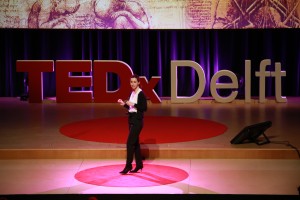TEDxDelft 2016 | Beatriz Seoane de la Cuesta | Tiny pores with huge potential
 “What is the very first thing you want to do every morning, right after you wake up? I could be honest and say ‘kiss my husband’, but the truth is I am ready to go to work. I enjoy every day being surrounded by science and microscopes!” declared Beatriz Seoane de la Cuesta at the opening of her talk about nanostructured porous materials.
“What is the very first thing you want to do every morning, right after you wake up? I could be honest and say ‘kiss my husband’, but the truth is I am ready to go to work. I enjoy every day being surrounded by science and microscopes!” declared Beatriz Seoane de la Cuesta at the opening of her talk about nanostructured porous materials.
The fact that few of us have heard of these little phenomena is rapidly about to change as science and technology explore the potential of these materials to tackle global societal challenges such as climate change, pollution, and the ongoing task of satisfying society’s high demands for energy in a sustainable manner.
Consider the combustion of coal and natural gas that we use to produce the energy we need, creating tiny molecules. These gas molecules have different sizes, making gas separation difficult and expensive. But what if there was a way to filter them? Enter the nanostructured porous materials. Imagine a sponge with holes perfectly ordered and very small, the size of different molecules. Nanostructured porous materials have a perfect order and structure at the nanoscale, one million times smaller than the tip of a pen, and yet they can be used as a molecular sieve to filter the tiny molecules.
The main obstacle Seoane observes in the effort to realize the potential of nanoporous materials is the issue of their “processability”, a key property in material science. Traditional tools cannot be used to process nanomaterials. But nature might offer help. Consider bones – two materials compose them, but as they are extremely ordered there is an extraordinary design. Bones can be 3D printed for bio-medical purposes, meaning that it could perhaps be possible to print these nanomaterials as well.
We could be closer to a cleaner atmosphere and more efficient use of the resources we have. “So let us follow our passions,” she said. “Tiny things can solve big problems.”
